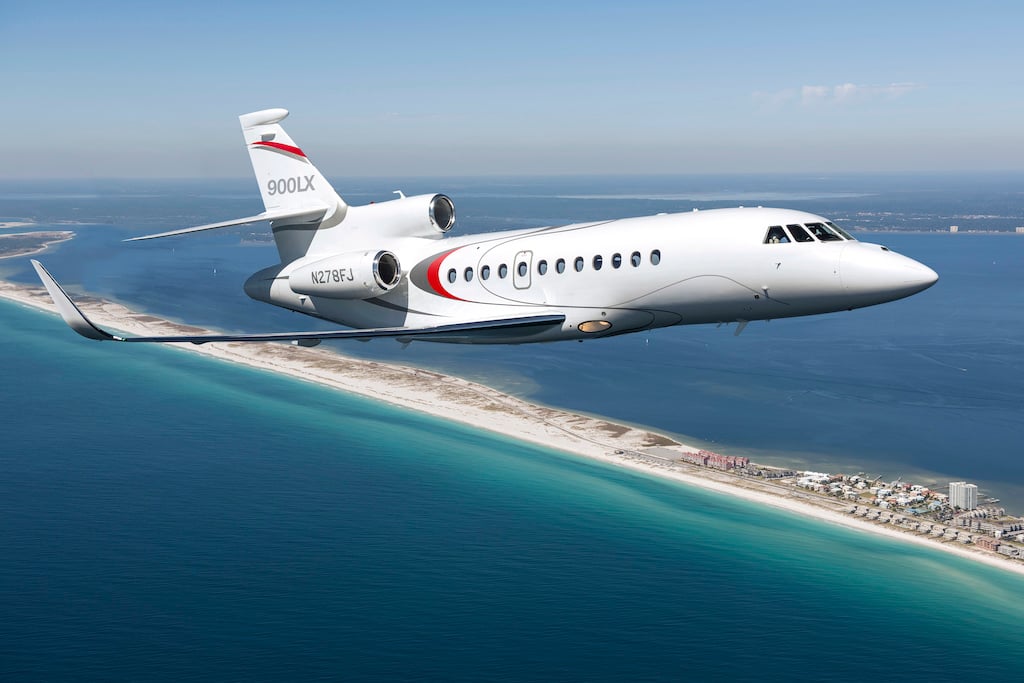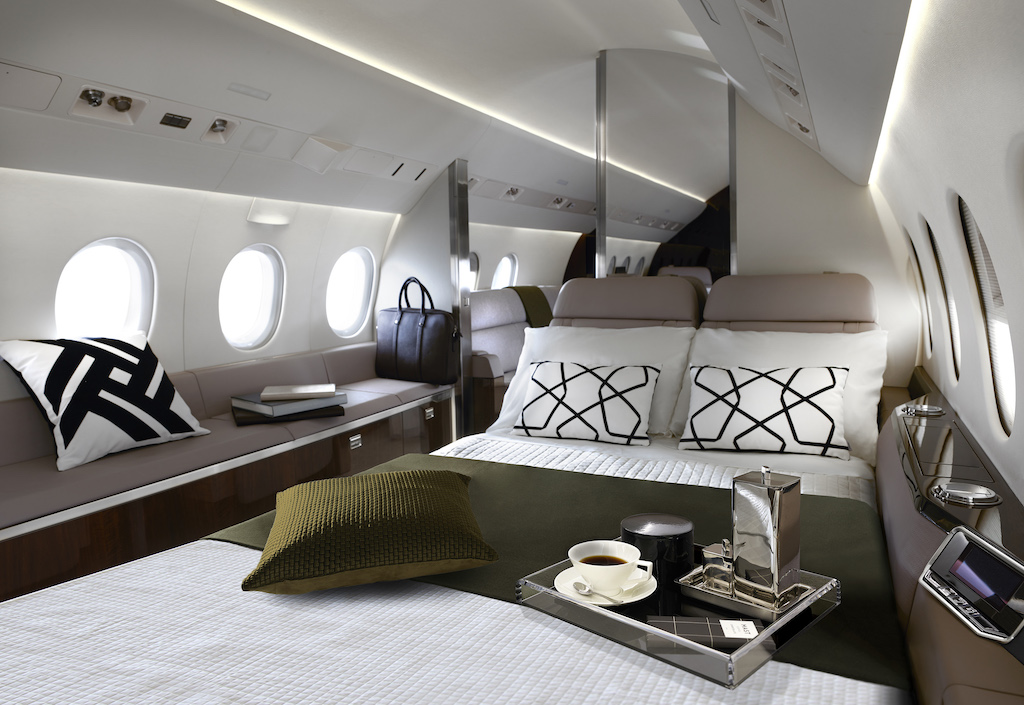
A Falcon 900B with aftermarket Aviation Partners Inc. winglets from the legacy fleet introduced in the late 1980s.
First delivered in 1986, the Dassault Falcon 900 trijet has evolved and improved through seven iterations, although its customer appeal over nearly four decades has remained constant, pre-owned sales executives say.
“The Falcon 900 aircraft are loved by many owners and operators and will continue to be a standout in the market for many years to come,” assured David Foster, vice president of aircraft sales with QS Partners, which tracks all Dassault Falcon types. “The bottom line is Falcon markets are still very active and quality aircraft continue to be difficult to locate. Limited inventory along with strong lift demand has allowed values to remain at historic highs.”
The Dassault trijet entered the market as competition for the Canadair (later Bombardier) Challenger 601 and Gulfstream III and IV twinjets. The late David North, who served as a test pilot for Aviation Week & Space Technology and later became its editor-in-chief, remarked on Dassault’s confidence in the Falcon 900 in 1985 when the manufacturer allowed him to fly the first prototype of the trijet after it had accumulated just 110 hr. of flight testing.
“Dassault-Breguet’s Falcon 900, a larger version of the three-engine Falcon 50, combines increased cabin size with a long-range capability and offers operators a corporate aircraft with excellent short-field performance, handling characteristics and environmental acceptance,” North wrote in the March 4, 1985, issue of the magazine.
“A frequent criticism by corporate operators about the Falcon 50 is that the smaller Falcon trijet is a long-range aircraft that does not have space to hold six or more passengers comfortably for the 10-hr. flights of which it is capable,” North elaborated. “The Falcon 900—its ancestry quite apparent in the smaller Falcon 50—has a cabin size that more than matches the range and endurance of the standard 12-passenger aircraft.”
The aerospace industry itself has evolved since North’s pilot report. Dassault stopped using the name Breguet in 1990. The Sperry Corp. electronic flight instrument system he described would evolve into a Honeywell product; so too would the Garrett TFE731-5A engines, via AlliedSignal, which merged with Honeywell in 1999 and retained its name.
Falcon 900 Iterations

The Falcon 900A offered good performance, a spacious cabin and long-distance range of 3,800 nm when it entered the market. The 900B version in 1991 introduced higher-thrust (4,750-lb.) TFE731-5BR engines with increased range to 4,000 nm. The 900EX followed in 1995 with 5,000-lb.-thrust TFE731-60 engines, range of 4,500 nm, and Honeywell Primus 2000 avionics. The 900C with Primus 2000 avionics and a higher gross weight replaced the B version in 1999.
Dassault overhauled the flight deck and introduced the Falcon 900EX EASy derivative in 2003, fitted with Honeywell’s Primus Epic integrated avionics system. In 2005, the manufacturer offered a shorter-range (4,100 nm) version of the C model—the 900DX—that incorporated the same engines and cockpit of the 900EX EASy, with a redesigned fuel system.
The current Falcon 900LX, certified in 2010, came equipped with the EASy II flight deck and blended winglets from Aviation Partners, which reduce drag and improve climb performance. With the LX designation, the manufacturer incorporated the winglets at the factory in France under a Dassault modification.
New Technology And Retrofits

In 2016, Dassault obtained FAA and European Union Aviation Safety Agency certification of its FalconEye head-up display system on the Falcon 2000 and 900, followed the next year by the 8X. FalconEye is a combined vision system; it presents database-sourced synthetic vision system imagery at the top of the combiner glass and infrared enhanced vision at bottom, divided by a horizontal split line that pilots can adjust up or down.
Dassault Aviation announced in September 2022 that it had received FAA supplemental type certification approval for installation of the Universal Avionics’ InSight flight deck upgrade of the Falcon 900B, making it compatible with current datalink systems. Earlier this year, the manufacturer named Universal Avionics as a North American repair facility for the FalconEye enhanced flight vision system, which is available on the Falcon 900LX, 2000 and 8X models.
The factory-new list price of a Falcon 900 in 1986 was $13.95 million, according to the Aircraft Bluebook. The sticker price of a Falcon 900LX in 2022 was $44 million.
Performance characteristics that impressed North when he flew a prototype Falcon 900 endure in the current-production model. “The -900 has a really good approach speed, a good low Vref (landing reference) speed,” observes Mark Verdesco, Dassault Falcon Jet director of pre-owned aircraft sales.
“You have that three-engine safety,” Verdesco adds. “With the inboard and outboard leading-edge devices on the wings and the third engine, you’ve got tremendous short-field performance and high-and-hot capabilities. That’s why it’s a great airplane for those short runways or for the Aspens or Saint Moritz or any of those high-end resorts.”
As of March, there were 190 legacy Falcon 900B/Cs in service or in the possession of non-operators, according to the Aviation Week Fleet Discovery Database. The bulk of the legacy fleet—144 aircraft—is based in North America. There were 347 Falcon 900EX, EX EASy, DX and LX models in service.
There were 11 legacy Falcon 900Bs listed for sale in March, Foster said. There were seven Falcon 900EXs for sale. Asking prices for the latter model introduced in 1995 ranged from $5 million to $11 million.
“The value of each aircraft depends on several factors to include the age, history, hours, equipment, engine programs, configuration, cosmetic condition, and where the aircraft is in the maintenance life cycle,” Foster advises. “It is important to be able to show a client where an aircraft stands today, but also advise them on what expenses they can expect in the future. The major inspections for legacy aircraft can be expensive, exceeding $1 million in some cases. Ensuring clients understand all sides of the acquisition and operation of the aircraft is critical.”
Foster reported five Falcon 900EX Easy models listed for sale, from the fleet produced from 2003 to 2011. Asking prices ranged from $15 million to $20 million. In the previous year there were 17 confirmed retail transactions, Foster said, indicating a strong market.
Current Production 900LX

The Aviation Fleet Discovery Database counted 86 in-service Falcon LXs, the current production model dating to 2010. The LX model competes for sales with the twin-engine Gulfstream G500; there were no LXs listed for sale as of March. Foster reported three confirmed retail 900LX transactions in the previous 12 months.
The 900LX is powered by a triad of Honeywell TFE731-60 turbofans, each producing 5,000 lb. of thrust. It can fly to a range of 4,750 nm at Mach 0.80 with six passengers and two crew. At max takeoff weight (49,000 lb.), it requires 5,360 ft. of runway in ISA sea level conditions.
“With the new high-Mach blended winglets, the 900LX has increased the range to 4,750 miles [with] a decreased fuel burn, making the aircraft one of the most efficient aircraft in its class,” Foster says. “Other notable improvements on the Falcon 900LX are the state-of-the-art EASy II flight deck, the fighter-derived technology for the airframe and aerodynamics, and the Falcon 900LX trijet configuration of Honeywell TFE731-60 engines. All of the above allow the Falcon 900LX to stand out as one of the premium aircraft in its class.”
Standup And Walkaround Cabin

The Falcon 900LX cabin is 6 ft., 2 in. in height, 7 ft., 8 in. wide and 33 ft., 2 in. long, with three passenger zones. “[This is] a true stand-up, walkaround cabin with three zones of comfort,” says Foster. “The cabin has the most modern entertainment and connectivity capabilities and is church quiet. The aircraft typically seats 12-to-14 passengers in one of the finest interiors in the industry.”
Dassault finishes the jet at its completions center at Clinton National Airport in Little Rock, Arkansas. The standard configuration is a 12-passenger layout comprised of four-place club seating forward, a four-place dining group opposite a credenza at mid-cabin; and a three-place divan across from one or two executive seats aft. An aft lavatory is standard; a forward crew lavatory near the galley is optional. Passengers have access to their luggage in flight.
BCAʼs 2022 Operations Planning Guide estimates Falcon 900LX direct costs of $7,339 for a 1,000-nm mission, based on a nationwide average Jet-A fuel cost of $6.94 per gal. at the time of publication. Direct costs include mission fuel consumed, maintenance labor, parts and reserve costs apportioned to the actual flight time for the mission length.
The Falcon 900 has a 12-, 24- and 36-month inspection schedule to ensure the aircraft’s condition regardless of its utilization rate. At every 1,600 flight hrs., a B maintenance inspection ensures system functional capabilities. A C-check inspection, the most comprehensive, must be performed every 3,750 flight cycles or in six years, whichever is reached first.
In April, the FAA issued airworthiness directives (AD) 2023-04-10 and 2023-04-16 applying to the Dassault Mystere-Falcon 900 and Falcon 900EX, respectively. The ADs supersede earlier directives to revise existing maintenance or inspection programs to incorporate new or more restrictive airworthiness limitations.
BCA welcomes comment and insight from aircraft dealers and brokers for its monthly 20/Twenty pre-owned aircraft market feature. The focus aircraft for May 2023 is the Embraer Praetor 500/600 and for June 2023, the Piaggio Avanti. To participate, contact [email protected].





